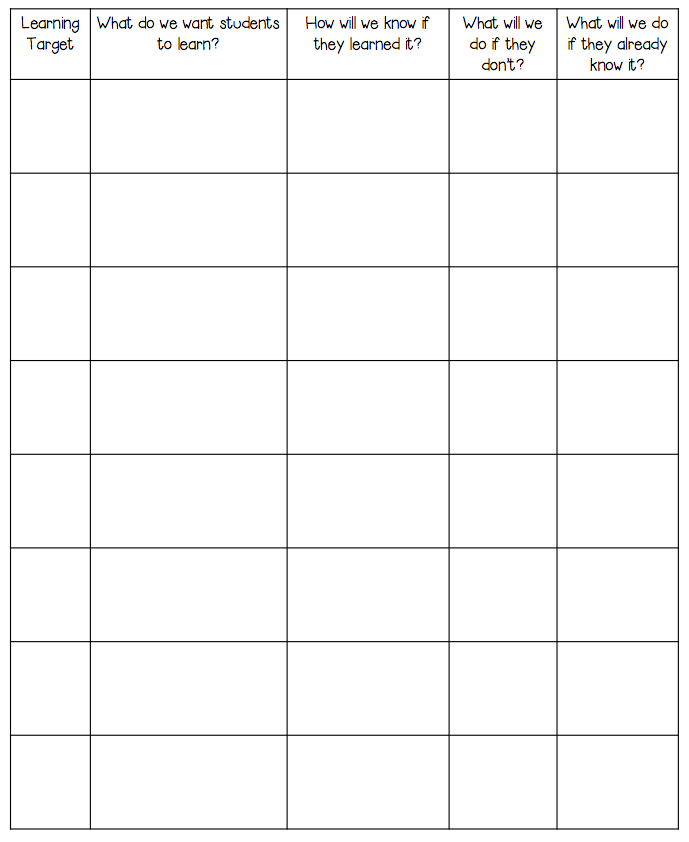Unit planning is a task!
One of the things I saw teachers struggling with is what to teach on which day! I think that is the struggle for all of us. When you get a list of TEKS and a set number of days it is easy to feel overwhelmed. I want to share how I plan for a unit.
- The first step is to decide what you want the students to learn. I start with a 5 column chart. (See sample - click on picture for link to Learning Target form) This chart helps me to decide what I want the students to learn. I break the TEKS into small chunks. I only include one verb and one piece of content. For example: If the TEKS is 3.4(A) solve with fluency one-step and two-step problems involving addition and subtraction within 1,000 using strategies based on place value, properties of operations, and the relationship between addition and subtraction, then I would write 9 learning targets. I would not expect to have 9 days to teach this TEK, but there are 9 skills a student needs to be able to do in this TEK:
- solve with fluency one-step problems involving addition within 1,000 using strategies based on place value.
- solve with fluency one-step problems involving addition within 1,000 using strategies based on properties of operations
- solve with fluency one-step problems involving addition within 1,000 using strategies based on the relationship between addition and subtraction
- solve with fluency one-step problems involving subtraction within 1,000 using strategies based on place value
- solve with fluency one-step problems involving subtraction within 1,000 using strategies based on properties of operations
- solve with fluency one-step problems involving subtraction within 1,000 using strategies based on the relationship between addition and subtraction
- solve with fluency one-step and two-step problems involving addition and subtraction within 1,000 using strategies based on place value
- solve with fluency one-step and two-step problems involving addition and subtraction within 1,000 using strategies based on properties of operations
- solve with fluency one-step and two-step problems involving addition and subtraction within 1,000 using strategies based on the relationship between addition and subtraction
The next step is to decide how I will know if the student can do the skill. I look to see how it is tested on STAAR. (STAAR is the Texas state assessment.) I make sure ALL of the skills listed in the TEKS are written down. I use this information to create my unit test and daily exit tickets. Then I create an exit ticket for each learning target.
The third step is to plan for intervention. I try to think of all the activities and strategies I know that might help if a student doesn't understand the learning target. I make these notes in the third column.
Next, I plan for enrichment. I look at the standards that are coming up that are related to this TEK or look at the next grade level for the connected skill. I then try to think of at least one thing for each learning target that will grow the math understanding for the kids who already get it.
Now I can start to put things on the calendar! I block of the number of days I have to teach and then look for learning targets that go together and put those on the calendar. In the example above, I would put Learning Target 1 and 3 together. If you have other TEKS done as learning targets you will find that you can teach multiple parts of TEKS on the same day.
After I get the learning targets on the calendar, I decide how my whole class teach time will go. I have a list of different ways to teach durning whole class teach time from Laney Sammon's book: Guided Math: A Framework for Mathematics Instruction. (If you haven't read this book, I highly encourage you to! It has changed the way I teach Math!) I try to vary my instruction. This keeps me from defaulting to the mini-lesson. I want the kids to do more work than me!

Next, I plan for Guided Math. I find hands-on activities that students can do at the small group table. I want them to be quick and action packed!
Finally, I write the daily plans! Most of the decision making is done. I look at the exit ticket for that day and make sure I am on track with my teaching!
Once the unit planning is done, I know I will stay focused and have ways to track student progress. I use the learning target sheet to create a student tracking form so kids can see where they are! These are great to use during parent conferences! I also have plenty of data to take to RTI meetings!
I usually map two or three units at a time so I don't get behind!


Facebook Comments